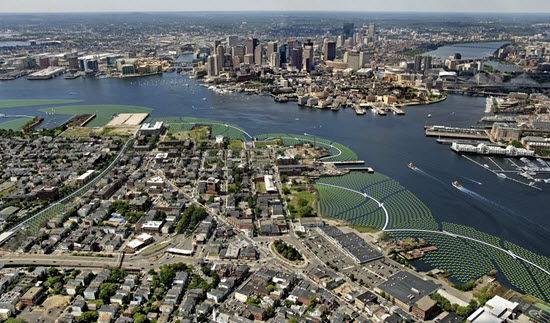A sustainable, climate-change-resilient floating landscape infrastructure took the top prize of the American Society of Civil Engineer’s latest Innovation Contest.
The winner, Emerald Tutu, provides a floating waterfront infrastructure that provides a city with an inhabitable waterfront amenity while mitigating the effects of climate change. “The contest is a springboard for forward-looking infrastructure ideas and aims to identify cutting-edge ideas from civil engineers, including students, educators, practitioners, and project managers,” according to an ASCE news release.
Another concept, “Smart Walls: Telescopic Structural Walls for Flood Protection,” also addressed climate resiliency. Smart Walls are deployable walls that are hidden in the ground and extend telescopically when needed to stop floodwaters.
The winner in the Best Student Submission category: “Rapid Restoration of Deteriorated Pre-stressed Concrete Bridges Using Mechanically Fastened Fiber Reinforced Polymer,” addressed deteriorated pre-stressed concrete bridge superstructure. It proposed a method to extend the useful life of infrastructure at low cost.
The Emerald Tutu from Very Flat on Vimeo.
Related Stories
Fire and Life Safety | Oct 4, 2022
Fire safety considerations for cantilevered buildings
Bold cantilevered designs are prevalent today, as developers and architects strive to maximize space, views, and natural light in buildings. Cantilevered structures, however, present a host of challenges for building teams, according to José R. Rivera, PE, Associate Principal and Director of Plumbing and Fire Protection with Lilker.
Resiliency | Sep 30, 2022
Designing buildings for wildfire defensibility
Wold Architects and Engineers' Senior Planner Ryan Downs, AIA, talks about how to make structures and communities more fire-resistant.
| Sep 30, 2022
Lab-grown bricks offer potential low-carbon building material
A team of students at the University of Waterloo in Canada have developed a process to grow bricks using bacteria.
| Sep 27, 2022
New Buildings Institute released the Existing Building Decarbonization Code
New Buildings Institute (NBI) has released the Existing Building Decarbonization Code.
| Sep 22, 2022
Gainesville, Fla., ordinance requires Home Energy Score during rental inspections
The city of Gainesville, Florida was recently recognized by the U.S. Dept. of Energy for an adopted ordinance that requires rental housing to receive a Home Energy Score during rental inspections.
| Sep 19, 2022
New York City construction site inspections, enforcement found ‘inadequate’
A new report by the New York State Comptroller found that New York City construction site inspections and regulation enforcement need improvement.
| Sep 16, 2022
Fairfax County, Va., considers impactful code change to reduce flood risk
Fairfax County, Va., in the Washington, D.C., metro region is considering a major code change to reduce the risk from floods.
| Sep 13, 2022
California building codes now allow high-rise mass-timber buildings
California recently enacted new building codes that allow for high-rise mass-timber buildings to be constructed in the state.
| Sep 8, 2022
U.S. construction costs expected to rise 14% year over year by close of 2022
Coldwell Banker Richard Ellis (CBRE) is forecasting a 14.1% year-on-year increase in U.S. construction costs by the close of 2022.
| Aug 29, 2022
Montana becomes first U.S. state to approve 3D printing in construction
Montana is the first U.S. state to give broad regulatory approval for 3D printing in building construction.

















